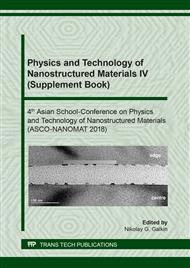[1]
J.M.. Rosas, R. Berenruer, M. J. Valero-Romero, J. Rodriguez-Mirasol and T. Cordero, Frontiers in Materials Carbon-Based Materials. 1 (2014) 1-17. Information on www.frontiersin.org.
Google Scholar
[2]
S.V. Gnedenkov, D.P. Opra, S.L. Sinebryukhov, A.K. Tsvetnikov, A.Y. Ustinov, V.I. Sergienko, Hydrolysis lignin: electrochemical properties of the organic cathode material for primary lithium battery, J. Ind. Eng. Chem. 20 (2014) 903-910.
DOI: 10.1016/j.jiec.2013.06.021
Google Scholar
[3]
G. Milczarek, O. Inganäs, Renewable cathode materials from biopolymer/conjugated polymer interpenetrating networks, Science. 335 (2012) 1468-1471.
DOI: 10.1126/science.1215159
Google Scholar
[4]
Yu.M., Nikolenko, D.P. Opra, A.K. Tsvetnikov, A.A. Sokolov, A.M. Ziatdinov, S.V. Gnedenkov, Lignin, its graphitized and fluorinated derivatives: The prospects of application as electrode-active component of lithium battery, Izvestiya Vysshikh Uchebnykh Zavedeniy Seriya Khimiya I Khimicheskaya Tekhnologiya,. 59 (2016) 92-98.
DOI: 10.6060/tcct.20165909.15y
Google Scholar
[5]
M. Kijima, T. Hirukawa, F. Hanawa, T. Hata, Thermal conversion of alkaline lignin and its structured derivatives to porous carbonized materials, Bioresource Technology. 102 (2011) 6279-6285.
DOI: 10.1016/j.biortech.2011.03.023
Google Scholar
[6]
Yu.M. Nikolenko and A.M. Ziatdinov, Nanographite Films: Structure and Properties, Solid St. Phenomena. 247 (2016) 17-23.
DOI: 10.4028/www.scientific.net/ssp.247.17
Google Scholar
[7]
S.V. Gnedenkov, D.P. Opra, L.А. Zemnukhova, S.L. Sinebryukhov, I.A. Kedrinskii, O.V. Patrusheva, V.I. Sergienko, Electrochemical performance of Klason lignin as a cathode-active material for lithium battery, J. Energ. Chem. 24 (2015) 346-352.
DOI: 10.1016/s2095-4956(15)60321-7
Google Scholar
[8]
Dippel B, Jander H, Heintzenberg J. NIR FT Raman spectroscopic study of flame soot, Phys. Chem. Chem. Phys. 1 (1999) 4707-4712.
DOI: 10.1039/a904529e
Google Scholar
[9]
T. Jawhari, A. Roid and J. Casado, Raman spectroscopic characterization of some commercially available carbon black materials, Carbon. 33 (1995) 1561-1565.
DOI: 10.1016/0008-6223(95)00117-v
Google Scholar
[10]
A.C. Ferrari and J. Robertson, Interpretation of Raman spectra of disordered and amorphous carbon, Phys. Rev. B. 61 (2000) 14095-14107.
DOI: 10.1103/physrevb.61.14095
Google Scholar
[11]
F. Tuinstra, J.L. Koenig, Raman Spectrum of Graphite, J. Phys. Chem. 53 (1970) 1126-1130.
Google Scholar
[12]
L. G. Cançado, K. Takai, T. Enoki, M. Endo, Y. A. Kim, H. Mizusaki, A. Jorio, L. N. Coelho, R. Magalhães-Paniago, M. A. Pimenta, General equation for the determination of the crystallite size La of nanographite by Raman spectroscopy, Applied Phys. Let. 88 (2006) 163106. Information on http://apl.aip.org/apl/copyright.jsp.
DOI: 10.1063/1.2196057
Google Scholar
[13]
L. Zhao, W. Wang, A. Wang, K. Yuan, S. Chen, Y. Yang, A novel polyquinone cathode material for rechargeable lithium batteries, J. Power Sources. 233 (2013) 23-27.
DOI: 10.1016/j.jpowsour.2013.01.103
Google Scholar
[14]
W.A. Schalkwijk, B. Scrosati, Advances in lithium-ion batteries, Springer science+business media, Berlin, 2002, 513 p. ISBN 978-0-306-47508-5.
Google Scholar
[15]
E.J. Yoo, J. Kim, E. Hosono, H. Zhou, T. Kudo, I. Honma, Large Reversible Li Storage of Graphene Nanosheet Families for Use in Rechargeable Lithium Ion Batteries, Nano Letters. 8 (2008) 2277-2282.
DOI: 10.1021/nl800957b
Google Scholar


